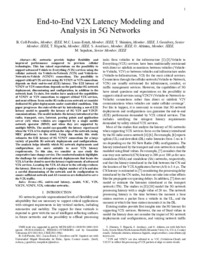Título :
End-to-End V2X Latency Modeling and Analysis in 5G Networks |
Autor :
Coll-Perales, Baldomero 
Lucas-Estañ, M. Carmen 
Shimizu, T.
Gozalvez, Javier 
Higuchi, T.
Avedisov, S.
Sepulcre, Miguel  |
Editor :
Institute of Electrical and Electronics Engineers |
Departamento:
Departamentos de la UMH::Ingeniería de Comunicaciones |
Fecha de publicación:
2022-11 |
URI :
https://hdl.handle.net/11000/31367 |
Resumen :
networks provide higher flexibility and improved performance compared to previous cellular technologies. This has raised expectations on the possibility to support advanced Vehicle to Everything (V2X) services using the cellular network via Vehicle-to-Network (V2N) and Vehicle-to-Network-to-Vehicle (V2N2V) connections. The possibility to support critical V2X services using 5G V2N2V or V2N connections depends on their end-to-end (E2E) latency. The E2E latency of V2N2V or V2N connections depends on the particular 5G network deployment, dimensioning and configuration, in addition to the network load. To date, few studies have analyzed the capabilities of V2N2V or V2N connections to support critical V2X services, and most of them focus on the 5G radio access network or consider dedicated 5G pilot deployments under controlled conditions. This paper progresses the state-of-the-art by introducing a novel E2E latency model to quantify the latency of 5G V2N and V2N2V communications. The model includes the latency introduced at the radio, transport, core, Internet, peering points and application server (AS) when vehicles are supported by a single mobile network operator (MNO) and when they are supported by multiple MNOs. The model can quantify the latency experienced when the V2X AS is deployed from the edge of the network (using MEC platforms) to the cloud. Using this model, this study estimates the E2E latency of 5G V2N2V connections for a large variety of possible 5G network deployments and configurations. The analysis helps identify which 5G network deployments and configurations are more suitable to meet V2X latency requirements. To this aim, we consider as case study the cooperative lane change service. The conducted analysis highlights the challenge for centralized network deployments that locate the V2X AS at the cloud to meet the latency requirements of advanced V2X services. Locating the V2X AS closer to the cell edge reduces the latency. However, it requires a higher number of ASs and also a careful dimensioning of the network and its configuration to ensure sufficient network and AS resources are dedicated to serve the V2X traffic.
|
Palabras clave/Materias:
5G
end-to-end latency
model
V2C
V2N
V2C2V
V2X
vehicular networks |
Área de conocimiento :
CDU: Ciencias aplicadas: Ingeniería. Tecnología |
Tipo de documento :
info:eu-repo/semantics/article |
Derechos de acceso:
info:eu-repo/semantics/openAccess
Attribution-NonCommercial-NoDerivatives 4.0 Internacional |
DOI :
https://doi.org/10.1109/TVT.2022.3224614 |
Aparece en las colecciones:
Artículos Ingeniería Comunicaciones
|
 La licencia se describe como: Atribución-NonComercial-NoDerivada 4.0 Internacional.
La licencia se describe como: Atribución-NonComercial-NoDerivada 4.0 Internacional.
.png)
